The cost of living in Arlington Heights, IL, offers a unique blend of suburban charm and urban convenience that draws many people to this vibrant community.
Situated just northwest of Chicago, Arlington Heights is a locale where the quality of life is reflected in its cost of living, which is slightly higher than the national average but comes with the benefits of a well-rounded suburban life close to a major city.
Housing here, while more expensive compared to other regions in Illinois, offers residents a variety of options from quaint, historic homes to modern apartments close to downtown amenities and excellent transit options.
Living in Arlington Heights, IL, with its reputable schools, abundant parks, and a thriving cultural scene, is particularly appealing.
The town’s commitment to maintaining a lively community atmosphere alongside well-maintained public spaces ensures it remains a top choice for families and professionals alike.
This is evidenced by the steady influx of new residents who are eager to take advantage of the area’s amenities, strong education system, and community-oriented lifestyle, marking it as a sought-after destination for many looking for a balanced suburban life.
Housing
In Arlington Heights, IL, the housing market is notably more expensive than both the national and state averages. A typical home in this suburb is priced at around $363,900, which is 7.6% above the national average home cost of $338,100.
This price difference is even more stark when compared to the average home cost in Illinois, which stands at $241,700; homes in Arlington Heights are 50.6% more expensive.
This indicates a significant premium that residents pay for the benefits of living in this suburb, likely influenced by its proximity to Chicago and the high quality of local amenities and services.
Renting in Arlington Heights also reflects a similar trend in pricing. The cost of renting a two-bedroom unit averages $1,700 per month, which surpasses the national average of $1,430 by 18.9% and is 25.9% higher than the Illinois average of $1,260 per month.
This higher rental cost can be attributed to the suburb’s desirable location, community features, and perhaps the overall higher standard of living that it offers compared to many other areas in the state.
Transportation
Arlington Heights, Illinois, benefits from a robust transportation infrastructure that effectively supports both local and regional travel needs.
The village features two Metra train stations which provide residents with quick and convenient access to downtown Chicago, making it a preferred choice for commuters.
The typical train journey to Chicago during rush hour takes just over 30 minutes. Additionally, the area is serviced by Pace buses, offering extensive routes throughout the village and to surrounding areas, including direct routes to O’Hare International Airport.
Commuting within Arlington Heights itself or to neighboring cities is facilitated by the strategic access to major highways such as Interstate 90 and Route 53, which connect the village to broader regional networks.
This connectivity is complemented by local transportation services like PACE Access Paratransit, which provides door-to-door service for elderly or disabled residents, and several taxi services, ensuring that all community members have reliable transport options.
The well-rounded transportation offerings of Arlington Heights make it a practical location for those looking to balance suburban living with easy urban access.
Groceries and Everyday Expenses
The cost of groceries in Arlington Heights is slightly above the national average, reflecting the general cost trends of the Chicago metropolitan area.
Residents have a variety of shopping options, from large grocery chains like Jewel-Osco and Trader Joe’s to smaller, specialty stores.
While the price for basic items like milk, bread, and eggs may be higher than in more rural areas of Illinois, shopping at local farmers’ markets or opting for store brands can help mitigate these costs.
In Arlington Heights, the cost of groceries is approximately 5% higher than the national average, reflecting the general cost trends of the suburban Chicago area.
Essentials such as a loaf of bread are priced at around $4.09, indicating a slight premium over prices you might find in less expensive regions of the country. Milk, a staple in many households, costs about $2.56 per gallon.
Eggs are also modestly priced at $2.37 per carton. For those looking to buy fruits, a bunch of bananas costs $3.54, which might be a bit higher compared to prices in grocery stores in other states.
Additionally, the price of a pound of hamburger meat stands at $5.41, showcasing the slight increase in costs that residents of Arlington Heights encounter when shopping for daily necessities.
These prices underscore the overall higher cost of living in the area, particularly in terms of day-to-day grocery expenses.
Utilities and Healthcare
Healthcare costs in Arlington Heights exceed the national average by 13%, reflecting a significant premium on medical services within the area.
For instance, a typical doctor’s visit can cost around $141.65, which is indicative of the higher healthcare standards and facilities available in the suburb.
Dental care, another essential health service, averages about $122.21 per visit, suggesting that even specialized medical services follow this trend of elevated prices.
Those needing optical services will find that an optometrist’s visit costs approximately $133.43. Prescription drugs also come at a higher cost, with average prices around $521.90, which could be a significant consideration for those managing chronic conditions.
Pet owners are not exempt from these higher costs, as a standard veterinary visit may cost about $64.11.
The average monthly energy bill in the area is approximately $171.69, a figure that encompasses costs for electricity and heating, which can fluctuate based on seasonal demands and home efficiency.
Additionally, the average monthly phone bill, including mobile and possibly landline services, is notably high at $184.70.
Education and Miscellaneous Expenses
The cost of education in Arlington Heights, Illinois, varies significantly between public and private institutions, reflecting the diversity and quality of educational options available in the area.
Township High School District No. 214, which serves Arlington Heights, is well-regarded with a high average graduation rate of 93% and a student-teacher ratio better than the national average.
This public district invests significantly in each student’s education, spending approximately $23,077 per student annually, which is nearly double the national average.
This investment is evident in the robust academic programs and the high proficiency levels in core subjects like math and reading.
On the private education front, Saint Viator High School, a prominent private Catholic institution in Arlington Heights, charges $16,500 for the 2024-25 school year, offering structured payment plans to aid affordability.
The school provides both need-based and merit-based scholarships, emphasizing its commitment to making education accessible.
Another private school, St. James School, offers education from PreK through 8th grade, with tuition rates varying by grade and parishioner status, peaking at $10,575 for non-parishioner students in grades 1-8.
They also offer financial aid and a rebate program to help manage these costs, demonstrating a community-oriented approach to education.
Lifestyle Factors
The lifestyle choices of residents in Arlington Heights, IL significantly influence their overall cost of living.
For those who enjoy the finer things in life, such as frequent dining at upscale restaurants, participating in various recreational activities, or indulging in high-end shopping, the expenses can indeed accumulate rapidly.
This suburb offers a plethora of gourmet dining options, luxury boutiques, and premium entertainment venues which, while enriching lifestyle, also reflect on monthly expenditures.
On the other hand, Arlington Heights also caters well to more budget-conscious residents.
The town boasts an array of cost-effective activities that do not compromise on quality of life. For example, the community is home to numerous well-maintained parks and recreational areas, which provide free or low-cost options for relaxation and exercise.
Additionally, Arlington Heights hosts various community events throughout the year—ranging from outdoor concerts to seasonal festivals—that offer entertainment without a hefty price tag.
The public amenities such as libraries and community centers further enrich residents’ lives without demanding much financially.
Thus, while the suburb can cater to luxury, it also supports a more economical lifestyle, making it a versatile place to live for a diverse range of budgets and preferences.
Final Thoughts
Arlington Heights offers a high quality of life with its safe neighborhoods, excellent schools, and community-oriented atmosphere.
While the cost of living here may be higher than the national average, many residents find that the benefits of living in this vibrant suburb outweigh the costs.
For anyone considering a move to Arlington Heights, it’s advisable to carefully evaluate your budget and lifestyle needs to ensure a smooth and enjoyable transition to this dynamic community.
In conclusion, while Arlington Heights may not be the cheapest place to live, its proximity to Chicago, combined with the quality of life it offers, makes it a worthwhile consideration for many looking to settle in the Chicago area.
Whether you’re a young professional, growing family, or retiree, Arlington Heights has something to offer for every stage of life.







